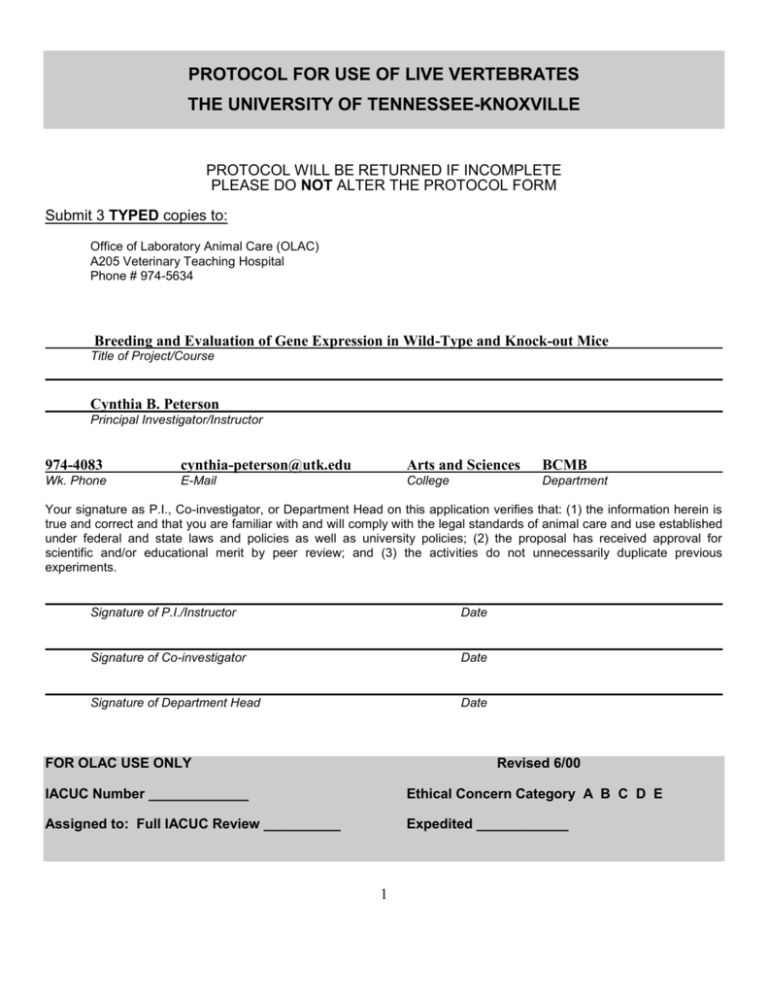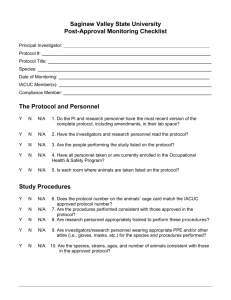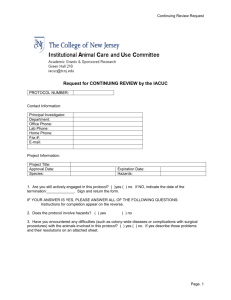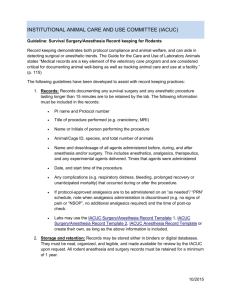protocol for use of live vertebrates
advertisement

PROTOCOL FOR USE OF LIVE VERTEBRATES THE UNIVERSITY OF TENNESSEE-KNOXVILLE PROTOCOL WILL BE RETURNED IF INCOMPLETE PLEASE DO NOT ALTER THE PROTOCOL FORM Submit 3 TYPED copies to: Office of Laboratory Animal Care (OLAC) A205 Veterinary Teaching Hospital Phone # 974-5634 Breeding and Evaluation of Gene Expression in Wild-Type and Knock-out Mice Title of Project/Course Cynthia B. Peterson Principal Investigator/Instructor 974-4083 cynthia-peterson@utk.edu Arts and Sciences BCMB Wk. Phone E-Mail College Department Your signature as P.I., Co-investigator, or Department Head on this application verifies that: (1) the information herein is true and correct and that you are familiar with and will comply with the legal standards of animal care and use established under federal and state laws and policies as well as university policies; (2) the proposal has received approval for scientific and/or educational merit by peer review; and (3) the activities do not unnecessarily duplicate previous experiments. Signature of P.I./Instructor Date Signature of Co-investigator Date Signature of Department Head Date FOR OLAC USE ONLY Revised 6/00 IACUC Number _____________ Ethical Concern Category A B C D E Assigned to: Full IACUC Review __________ Expedited ____________ 1 GENERAL INFORMATION 1. This is a [ ] New [X] 3-year rewrite [ X ] Research [ ] Teaching Courses/CE Seminars covered by this protocol: _____________________________________ 2. [ ] Yes [ X ] No This protocol includes the use of farm animals used or intended for use as food or fiber, or livestock or poultry used or for improving animal nutrition, breeding, management, or production efficiency, or for improving the quality of food or fiber. 3. Veterinarian responsible for clinical care [X] OLAC Staff Veterinarians [ ] Dr. Dallas Goble [ ] LACS Ambulatory Service for the Department of Animal Science [ ] Other, list If other, clinical veterinarian must follow the IACUC “Attending Veterinarian/Researcher Veterinarian” policy. 4. Funding Source: NIH, DOE 5. Non-Surgical Procedures (Pertains to any experimental procedure including non-surgical, pre-surgical and post-surgical procedures using animals) [..] NO 6. Surgical Procedures (Pertains to any surgical procedure, including non-survival surgery. If other procedures are done on animals prior to or after surgery, complete applicable sections.) [ X] NO 7. [ ] YES: Prescription Drugs/Controlled Substances [ X] NO 10. [ ] YES: (this section my be obtained from the OLAC office 974-5634) Hazardous Agents [ X] NO 9. [ ] YES: Field Studies Involving Wild Animals [ X] NO 8. [ X] YES: [ ] YES: Euthanasia [ ] NO [X ] YES: 2 A. NON-TECHNICAL SUMMARY Summarize, in lay person language (8th grade level), the rationale and purpose for the study, and the proposed use of the animals. Include time sequence of all procedures. For complex projects sequence of events can be depicted in a flow sheet (i.e., day one, group one, treatment; day two, etc.). For resubmissions, state what has been accomplished under this protocol so far. Please define acronyms and abbreviations. B. ANIMAL HOUSING FACILITIES In order to provide assurance of humane care and use of laboratory animals, all animal housing facilities on the UTK campus will be operated according to federal laws, AAALAC and NIH Guidelines, and the Guide for the Care and Use of Agricultural Animals in Agricultural Research and Teaching as appropriate. Housing of animals, including those actively on experiment, for periods longer than 12 hours, is restricted to facilities meeting such guidelines and laws. 1. Please check your preferred housing location. [X] [ ] [ ] [ ] [ ] [ ] [ ] [ ] [ ] College of Arts and Sciences Facility in the Walters Life Sciences Building (WLS). College of Human Ecology Animal Facility in the Jessie Harris Building. College of Veterinary Medicine (CVM) Laboratory Animal Facility VTH/Cherokee CVM Large Animal Clinical Sciences in VTH/Cherokee Farm CVM Small Animal Clinical Sciences Research Runs UT Medical Center Lab Animal Facility Joe E. Johnson Animal Research and Teaching Unit IACUC Approved Satellite Facility List bldg/room # *Other List: *Any newly established facility must be approved before housing animals. 2. Please list all special housing or husbandry requirements. N/A 3. Will wire bottom cages be used for rodents? If so, please provide scientific justification for use of wire bottom cages. No 4. Environmental enrichment is routinely provided for animals. Please indicate if environmental enrichment is NOT to be provided and justification why it would interfere with research. N/A In accordance with NIH Guidelines and Federal Law, the IACUC formally reviews all animal housing facilities and satellites semi-annually and files a report to the Office for Protection from Research Risks (OLAW) in Washington, DC and the United States Department of Agriculture (USDA). 3 In accordance with NIH Guidelines and Federal Law, the IACUC formally reviews all animal housing facilities and satellites semi-annually and files a report to the Office for Protection from Research Risks (OLAW) in Washington, DC and the United States Department of Agriculture (USDA). FLOW CHART ( INCLUDING EXACT ANIMAL MANIPULATIONS/PROCEDURES): ANIMAL BREEDING (ONGOING) MANIPULATIONS OF ANIMAL DIET (8 WEEK INTERVALS) TAIL BLEEDS (TWICE, 6 AND 8 WEEKS OF AGE) EUTHANASIA AND HARVESTING OF TISSUES (8 WEEKS UP TO 1 YEAR OF AGE) (ALL OF THESE PROECURES ARE EXPLAINED IN DETAIL IN THE SUPPLEMENTARY INFORMATION PROVIDED WITH THIS APPLICATION.) 4 C. 1. DESCRIPTION OF ANIMALS Common Name Strain/Breed Sex Weight/Age Source # per Day Total # per project (3 years) Mus musculus Various M/F 0-2 yrs 0-35 grams Harlan/Jax Mating pair plus Litters: 4-5 weamlings/cage 20/day 150/3 years Mus musculus VN-/- M/F 0-2 yrs 0-35 g Vitronectin Knockout Mouse from Univ. of Michigan Mating pair plus Litters: 4-5 weamlings/cage 20/day 150/3 years Animals will be removed from the animal housing facility: [ ] No [X ] Yes. Please answer the following: 1. Animals will be taken to (bldg/room number): WLS Room E312 2. Animal manipulations that will be performed in the laboratory include: euthanasia 3. Estimated total time period live animals will be kept in the laboratory: <1 4. Animals will be returned to the facility YES XNO 2. hours Disposal of animals after completion of activity: [ ] Return to production/breeding unit/facility inventory [ ] Slaughter, (must conform to the Humane Slaughter of Livestock, 9 CFR, part 313) [ ] Sold [ ] Transfer to another research project – please list protocol # and Investigator ___________________ [ X ] Euthanatized [ ] Returned to owner [ ] Other (Please describe) D. QUALIFICATIONS OF PERSONNEL List all individuals who will be working with the animals on this project. Include all investigators, student employees, post-doctoral researchers, staff research associates and laboratory assistants who will actually work with the animals. If personnel do not have experience, state how they will be trained. The Occupational Health Program (OHP) is mandatory for all personnel who work with laboratory animals. If an individual having animal contact is not currently enrolled in the occupational health program call the OLAC office at 974-5634 for information on enrolling. 5 Name/Degree(s) Cynthia Peterson OHP* X Christine R. Schar X E. Procedure(s)/Description of Relevant Experience All; already has received training in orbital bleeds for collecting blood; will receive training from lab personnel in Mary Ann Handel’s lab here at UTK for breeding and tail clips; also from Veterinary Staff All; has received training by Veterinary Staff ANIMAL WELFARE 1. In addition to procedures which obviously cause pain, distress, or discomfort, USDA (Policy 11 & 12) states that any procedure which requires the use of an anesthetic or analgesic to prevent pain or discomfort is by definition a painful procedure (examples of painful procedures include: survival and non-survival surgery, use of Freund’s Adjuvant, monoclonal antibody production, food/water deprivation, and application of noxious stimuli). According to the above definition does this project involve pain or distress? [ ] yes [X ] no If yes, please provide a written narrative that at minimum should include: a. b. c. d. the databases searched or other sources consulted to confirm that less painful alternative methods are not available, the date of the search and the years covered by the search, key words and/or search strategy used, a narrative written in such a way that the IACUC can readily assess whether the search topics were appropriate and whether the search was sufficiently thorough This search should consider: Replacement of existing animal methods with nonanimal methods whenever possible. Reduction of the number of animals needed. Refinement of research procedures to minimize pain and discomfort. 2. Does the proposed research duplicate any previous work? [ ] yes [ X] no If yes, explain why it is scientifically necessary to replicate the experiment. 3. Explain why the proposed species is/are the most appropriate. Our purpose in this study is to identify differences in gene and protein expression between the vitronectin knockout mouse and the wild-type mouse. The overall goal is to determine the importance of vitronectin in the human cardiovascular system. Mice are generally accepted as excellent models for human disease and physiology because of the extensive degree of homology between the mouse and human genomes. 4. Describe the steps you have taken to reduce the number of animals in your study. (refining experimental design, replacing animals with in vitro procedures, etc.) These studies are designed to give us multiple experiments without using an excessive number of animals. We have calculated the appropriate number of tissues needed for evaluation by microarray and proteome methods to ensure reliability and reproducibility of the data. 6 5. Provide an explanation of how the numbers of animals to be used were derived. If used in an experiment (test a hypothesis) numbers should be based on scientific and statistical requirements (ex: power tests or previous experience) to achieve objectives. The number of animals required was derived by determining that 3-4 replicate experiments are required to establish reproducibility of the data. We must compare differences between sexes. We also are interested in correlating changes in gene and/or protein expression with aging, measuring tissue-specific expression for newborns, weanlings, adult (~8 week) and old-age (~1218 month) ages. We will breed cages with 4-5 animals to ensure that we have enough animals for the different measurements. 6. DURING THE STUDY: a. How often will the clinical condition of animals be monitored? The condition of the animals will be checked daily. b. Who will monitor the clinical condition of the animals? WLS animal facility staff and Peterson staff c. Are animals expected to experience any specific study-induced or related problems (i.e. health problems, pain, distress, complications, etc.) or any health problems as a result of the phenotype of the animal? No d. What criteria will be used to assess pain, distress, or discomfort? Check all that apply: [X] [X] [x] [ ] [x] [ ] [ ] [ ] [X] [ ] [ ] [ ] [ ] [ ] Loss of appetite. Loss of weight. Restlessness. Abnormal resting postures in which the animal appears to be sleeping or is hunched up. Licking, biting, scratching, or shaking a particular area. Failure to show normal patterns of inquisitiveness. Failure to groom, causing and unkempt appearance. Guarding (protecting the painful area). Loss of mobility. Red stain around the eyes of rats. Unresponsiveness. Self-mutilation. Labored breathing. Other. (please list) e.What criteria will be used for removing animals from the study prematurely? Failure to thrive (as in d above) 7 NON-SURGICAL PROCEDURES 1. SITES OF STUDY Site of experimental work: :Walters Life Sciences Building Bldg. 2. Animal Care Facility Room STUDY PROCEDURES : Please check the following items that apply and fill out appropriate parts of this section. [ ] Polyclonal antibody production* [ X ] Blood* or other body fluid withdrawal, tissue collection, injections, tail clip, gavaging [ ] Restraint with mechanical devices [ ] Projects involving food and water deprivation, or dietary manipulation [ ] Tumor and disease models* or toxicity testing [ X ] Anesthesia or analgesia* (for non-surgical procedures) [ ] Behavioral studies [ ] Endoscopy, fluoroscopy, radiology, ultrasound, MRI, CT, PET, or other diagnostic procedures [ ] Monoclonal antibody production [ X ] Use of tissues, serum, tumor lines, hybridoma, etc. * The IACUC has approved guidelines for these procedures. Deviations must be justified. POLYCLONAL ANTIBODY PRODUCTION Describe procedure, antigen and adjuvants used, the ratio of antigen to adjuvant and routes and volumes of injection (Vol. should be < 0.25 ml per injection site; subcutaneous route is recommended): BLOOD OR BODY FLUID WITHDRAWAL/TISSUE COLLECTION/ INJECTIONS, TAIL CLIP, GAVAGING Describe in detail method(s), needle sizes, volume(s) collected or administered, and frequency of collection or injections: Body Fluid Withdrawal Tissue Collection Injection/ Infusion Tail Clip Gavaging Location Needle Size/ Catheter Size WLS Animal Facility A Hall Heparinized capillary tube for orbital bleed WLS Animal Facility A HNall N/A WLS Animal Facility A Hall Biopsy Size Volume Collected 100-200ul ul (less than 1% body weight) Volume Administered Frequency 2 times: at 48 weeks and again at 1218 mos Whole Liver or Heart Once upon sacrifice Less then 1 cm clip Once at 3 to 4 weeks age N/A 8 RESTRAINT WITH MECHANICAL DEVICES Describe device, duration of restraint, frequency of observation, conditioning procedures and steps to assure comfort and well-being: N/A PROJECTS INVOLVING FOOD AND WATER DEPRIVATION, OR DIETARY MANIPULATION Describe methodology. State objective criteria used to assess physical condition and pain, discomfort, stress, and distress during the course of study. Include clinical signs or manifestations expected from the procedure. What criteria will be used to determine a humane endpoint before severe morbidity and death? We plan to do a feeding study using a high-fat diet. This was approved in a supplement to our original application. The proposed diet is from Research Diets, #D12492 (*). The diet is a total 5.2 kcal/gm diet, with a 35%fat content (60%kcal). Please note that this feeding regimen will not be for all animals, but just for a test set of 4 males and 4 females. We will use the criteria of failure to thrive as defined under 6d to determine whether to halt feeding the high-fat diet. Food Restriction Fluid Restriction Nutrient Alterations Amount Restricted/Added Duration Compound Supplemented High-fat diet 8 wk D12492* Compound Deleted Frequency All meals TUMOR AND DISEASE MODELS, TOXICITY TESTING Describe methodology used for tumor/disease induction and/or toxicity testing. State objective criteria used to assess physical condition and pain, discomfort, stress, and distress during the course of study. Include clinical signs or manifestations expected from the procedure. What criteria will be used to determine a humane endpoint before severe morbidity and death? N/A ANESTHESIA/ANALGESIA/TRANQUILIZATION (OTHER THAN SURGERY) Adequate records describing anesthetic monitoring and recovery must be maintained and available to the attending veterinarian and animal care staff. Agent Isofluran Dose (mg/kg) 3-5% to effect Route Inhalation Frequency 2 times For which procedure Orbital bleeds Name and qualifications of person administering drugs: Christine Schar; already has been trained by Veterinary Staff 9 CRITERIA TO ASSESS LEVEL OF ANESTHESIA. Check all that apply: [ X ] Respiration rate [ X ] Heart rate [ ] ECG [ ] Toe pinch [ X ] Tail pinch [ ] Corneal reflex [ ] Color of mucous membranes [ ] Muscular relaxation [ ] Other (pulse oximeter, respirometer) please list _______________________________ ANESTHESIA RECOVERY MONITORING a. Will analgesia be provided? [ ] Yes [X] No If no, please explain why analgesics are withheld: The orbital bleeds are achieved quickly with minimal discomfort to the animal. Recovery from the anesthesia occurs quickly. b. What is the anticipated duration for recovery from anesthesia? 10 min c. How often will animal(s) be monitored during recovery? continuously d. What specifically will be monitored? Return to normal activity e. Who will be monitoring them? Cynthia Peterson and/or Christine Schar RECOVERY MONITORING a. Following anesthesia recovery, what parameters will be monitored? N/A b. Who will monitor the animals? N/A c. How frequently will animals be monitored? N/A BEHAVIORAL STUDIES Describe in detail types of behavioral manipulations, including placement in testing chambers or apparatus, use of aversive stimuli, duration of test periods, and frequency of test periods: N/A 10 ENDOSCOPY, FLUOROSCOPY, X-RAY, ULTRASOUND, MRI, CT, PET, OR OTHER DIAGNOSTIC PROCEDURES Describe, in detail, methodology and animal manipulations: N/A MONOCLONAL ANTIBODY PRODUCTION Please provide scientific justification explaining why specific in vitro monoclonal antibody production methods cannot be used. IACUC monoclonal antibody production guidelines must be followed. Any deviation from these guidelines must be specified and scientifically justified below. N/A USE OF TISSUES, SERUM, TUMOR LINES, HYBRIDOMA ETC. All tissues must be MAP or PCR tested to ensure that tissues are free of infectious agents. Please provide evidence of this testing: WLS Animal facility staff continually checks and runs tests on the animals housed in its facility by using clean sentinel mice, exposing them to the mice being used and then assaying for infectious agens in the sentinel mice. 11 SURGICAL PROCEDURES The attending veterinarian must be consulted on anesthetic regimens, surgical procedures and post-surgical care. Adequate records describing surgical procedures, anesthetic monitoring and postoperative care must be maintained and available to the attending veterinarian and animal care staff. TYPE OF SURGERY _X_ Nonsurvival surgery: (animals euthanized without regaining consciousness). __ Major survival surgery: (major surgery penetrates and exposes a body cavity or produces substantial impairment of physiologic function). __ Minor survival surgery. __ Multiple survival surgery? If yes, provide justification for multiple survival surgical procedures: 1. Surgeon’s name and experience with species and procedures to be performed: Christine Schar will be euthanizing animals. She will be trained by personnel in the Handel lab and by the UT Veterinary Staff. 2. Location where surgery will be done: WLS Animal Care Facility 3. Describe the pre-op preparation of the animals: a. b. 4. Minimal sterile techniques will include (check all that apply): [ ] [X] [ ] [ ] [ ] [ ] [X] [X] 5. Food restricted for ___1__ hours Water restricted for __1___hours Sterile instruments Sterile gloves Cap and mask Sterile gown Sterile operating area Clipping or plucking of hair or feathers Skin preparation with a sterilant such as betadine Practices to maintain sterility of instruments during surgery Describe the following surgical procedures: a. Skin incision size and location: Lower Abdomen and Chest Cavity b. 6. Method of skin closure: (type, suture size, suture pattern, etc.) N/A c: Describe surgery in detail: Animal is immediately sacrificed using cervical dislocation, an incision made in lower abdomen and chest cavity, liver and heart are extracted. W ILL PARALYZING DRUGS BE USED? [ X ] No [ ] Yes 12 Drug Dose IF YES, PLEASE JUSTIFY THE NEED TO USE PARALYZING DRUGS: 7. Anesthetic Protocol Pre-emptive analgesic Pre-anesthetic Anesthetic Analgesic Other Agent N/A N/A Isofluran N/A N/A Dose (mg/kg) Frequency 3-5% to effect once CRITERIA TO ASSESS LEVEL OF ANESTHESIA. Check all that apply: __ Respiration rate _X_ Heart rate __ ECG _X_ Toe pinch _X_ Tail pinch __ Corneal reflex __ Color of mucous membranes __ Muscular relaxation __ Other (pulse oximeter, respirometer) please list _______________________________ 8. 9. Describe any behavioral or husbandry manipulations that will be used to alleviate pain, distress, and/or discomfort. N/A ANESTHESIA RECOVERY MONITORING a. Will analgesia be provided? [ ] Yes [ ] No If no, please explain why analgesics are withheld: N/A b. N/A What is the anticipated duration for recovery from anesthesia? c. How often will animal(s) be monitored during recovery? N/A d. What specifically will be monitored? N/A e. Who will be monitoring them? N/A 10. POSTSURGICAL RECOVERY MONITORING a. Following recovery, what parameters will be monitored? 13 N/A b. N/A Who will monitor the animals? b.How frequently will animals be monitored? N/A 14 HAZARDOUS AGENTS 1. WILL ANIMALS BE SUBJECTED TO ANY OF THE FOLLOWING? NO 1. *Infectious Agents NO 2. *Toxic Chemicals or Carcinogens NO 3. *Recombinant DNA NO 4. *Malignant Cells or Hybridomas NO 5. **Radioisotopes NO 6. *Human tissue *Biosafety Committee approval required Approval Number N/A **Radiation Safety Committee approval required (Please attach approval letter) 2. IF YES, PLEASE COMPLETE THE ATTACHED ANIMAL HAZARD CONTROL FORM. N/A 3. Agent COMPLETE THE FOLLOWING CHART. Concentration Route of Administration 15 Duration of Exposure Post Exposure Maintenance of Animals ANIMAL HAZARD CONTROL FORM The Principal Investigator is responsible for informing all personnel handling animals of the hazards involved and precautions to be taken. The Principal Investigator is also responsible for updating the form in the case of changes in agent or experimental procedure. For assistance in completion of this form please contact the appropriate Safety Officer HAZARDOUS AGENTS Principal Investigator: Campus Phone: Department: E-Mail: Secondary Contact: Department: Campus Phone: Home Phone: Home Phone: E-Mail IACUC Protocol Number: Chemical Agent Used: Radioisotopes Used: Biosafety Level: Biohazardous Agents Used: SPECIAL PERSONAL PROTECTIVE EQUIPMENT REQUIRED: Route of Excretion: Precautions for Handling Live or Dead Animals: Animal Disposal: Bedding / Waste Disposal: Cage Decontamination: Additional Precautions to Protect Personnel, Adjacent Research, and Environment: Building: Room #: 16 LEGEND (PRESCRIPTION) DRUGS AND/OR CONTROLLED SUBSTANCES * Legend Drugs and Controlled Substances In Tennessee, it is not legal to divert drugs from clinical use to teaching and research use. You, or someone in your group acting as an agent for the group, must have a license for each individual legend drug that you might use in teaching or research. A legend drug is one where the label says “Federal Law restricts this drug to use by or on the order of a licensed veterinarian” or “Federal Law prohibits dispensing without a prescription”. If the drug is a controlled substance, you also need a license from the Drug Enforcement Administration for the specific drugs that you may use. Obtaining and using such drugs for research needs to be reviewed by the appropriate Committee. The use of legend drugs and controlled substances must be approved by the appropriate committee. Do you have the appropriate licenses and legend and controlled drug Committee approval for the drugs you will use in your project or class? [ ] NO [ ] YES N/A College of Veterinary Medicine personnel contact: Medical Center personnel contact All others contact: Bruce McNeil 974-5670 Mark Smith 544-9363 Brenda Lawson 974-3466 17 EUTHANASIA METHODS OF EUTHANASIA MUST COMPLY WITH THE 1993 REPORT OF THE AVMA PANEL ON EUTHANASIA OR OTHER IACUC APPROVED METHODS. DEPARTURES MUST BE JUSTIFIED. 1. METHOD OF EUTHANASIA _____ Anesthetic overdose. Drug:___________________ Dose: ___________________ Route: ___________________ _____ Decapitation under anesthesia or tranquilization _____ Decapitation without anesthesia or tranquilization* __X___ Cervical dislocation under anesthesia or tranquilization _____ Cervical dislocation without anesthesia or tranquilization* _____ Exsanguination under anesthesia __X___ Carbon dioxide exposure _____ Slaughter (covered under the Humane Slaughter of Livestock, 9 CFR, part 313) _____ Other: Specify: *PLEASE JUSTIFY ANY DEPARTURE FROM AVMA PANEL REPORT:(EX. CERVICAL DISLOCATION WITHOUT ANESTHESIA) 2. NAME AND QUALIFICATIONS OF PERSON(S) PERFORMING EUTHANASIA: Sally Fridge, WLS trained animal facility manager, and trained personnel in Peterson lab 3. METHOD OF DISPOSAL. EUTHANIZED ANIMAL CARCASSES MUST BE DISPOSED OF APPROPRIATELY. Please check the appropriate method: [ X ] incinerate [ ] by Radiation Safety [ ] carcass will contain hazardous agents and will be autoclaved prior to disposal [ ] slaughter (covered under the Humane Slaughter of Livestock, 9 CFR, part 313) [ ] necropsy [ ] other - describe: 18








